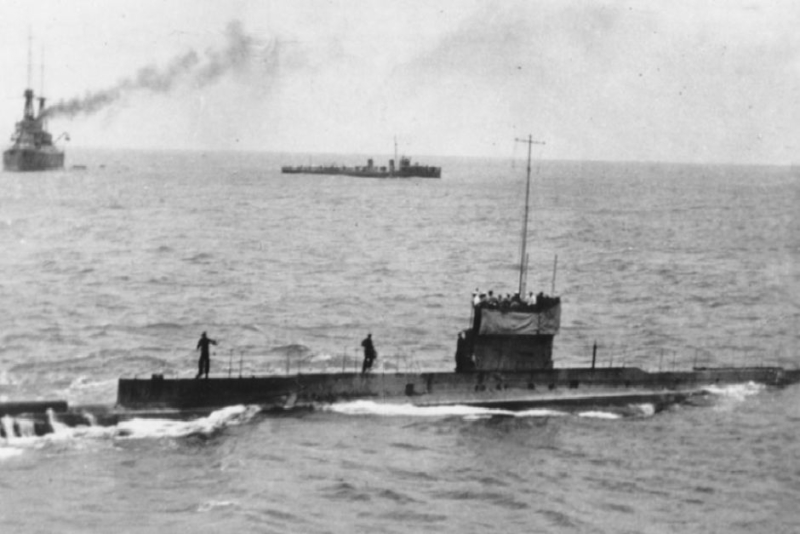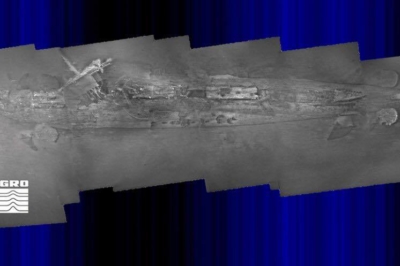One of Australia’s greatest naval mysteries has been solved. One hundred and three years after the disappearance of Australia’s first submarine the -AE1 has been discovered 300m down off the coast of the Duke of York Islands near Rabaul in Papua New Guinea.
Two E-Class submarines was purchased by the Australian government, the submarines were built by Vickers Ltd at Barrow-in-Furness in the UK. They were launched on 22 May 1913 and commissioned into service with the Royal Australian Navy on 28 February 1914. The two submarines would be designated AE-1 & AE-2, each boat had two propellers driven by a 800 brake-horsepower engine along with a 420 brake-horsepower electric engine. With top speeds of 15 knots on the surface and 10 knots when submerged. They had a top range of 3000 nautical miles and were armed with four 18-inch torpedo tubes.
When the two submarines entered Sydney Harbour in time to join the Empire Day Celebrations on 24 May 1914, they had already completed some remarkable feet, having travelled 83 days from England, 60 days of which at sea. The full compliment of the crew was 35 and for the AE1 a mixture of Royal Navy (RN) and Royal Australian Navy (RAN) personal made up the compliment.
Shortly after Britain declared war on Germany, 4 August 1914, the British Admiralty requested that Australia send a force to capture German New Guinea. As such a task force was created-the Australian Naval & Military Expeditionary Force (AN&MEF). AE1 was part of the Australian fleet that sailed to Rabaul. On 11 September 1914 after a short battle which resulted in the loss of six members of the ANMEF and one German, Australian forces successfully captured the German wireless station at Bita Paka.
The AE1 was commanded by Lieutenant Commander Thomas Fleming Besant, RN and a veteran of the Boxer Rebellion. He had entered service with the RN as a cadet and by 1903 had been promoted to Sub Lieutenant before deciding on a career in submarines. The AE1’s second-in-command was Irishman-Lieutenant Charles Lewis Moore also of the RN. Like Besant, he too was on loan to RAN from the RN. The boats third officer was The Hon. Lieutenant Leopold Florence Scarlett ex RN and now a commissioned officer in the RAN.
The names of the crew were as follows?
Telegraphist-Cyril L. Baker
Leading Stocker-Sidney C. Barton
Stoker-Ernest Blake
Stoker-John J. Bray
Leading Seaman-Gordon C. Corbould
Signalman-George Dance
Able Seaman-Frederick G. Dennis
ERA III-James A. Fettes
Able Seaman-Arthur H. Fisher
Petty Officer-Thomas M. Guilbert
Stoker-James Guild
Stoker-Henry J. Gough
Leading Stoker-William E. Guy
Petty Officer-Henry Hodge
Able Seaman-George Hodgkin
Stoker-Richard B. Holt
Able Seaman-Jack Jarman
Chief Era I-Thomas F. Lowe
Chief ERA II-John A. Marsland
Leading Stoker-John W. Meek
ERA III-John C. Messanger
Stoker PO-John J. Moloney
Able Seaman-John Reardon
Petty Officer-Robert Smail
Chief Stoker-Harry Stretch
Able Seaman-James B. Thomas
Petty Officer-William Tribe
Stoker PO-William A. Waddilove
Chief ERA II-Joseph W. Wilson
Stoker-Percy L. Wilson
Able Seaman-Frederick W. Woodland
Stoker PO-Charles F. Wright
On 14 September 1914 at 0700, AE1 left Simpson Harbour, Rabaul with the orders ‘to guard against approach of enemy from Southward in St Georges Strait’. HMAS Parramatta had been at night anchorage at Herbertshoho, Rabaul and was ordered to rendezvous with AE1 and to join in the patrol. The captain of Parramatta, reported that the two vessels met up a 8am. Both had strict orders to be back in port by sunset. After several communications between the AE1 & Parramatta on their patrol contact was lost around mid-afternoon. HMAS Parramatta returned to port but the AE1 was never seen again. Despite attempts to search for the AE1 by the Australian fleet no trace including debris was found.
Over the last one-hundred and three years, several attempts to locate the submarine have been attempted. In the 1970’s John Foster an RAN officer that was working in Port Moresby, took up the story and convinced the RAN to search for AE1 with the survey ship HMAS Flinders, although a potential lead was discovered, HMAS Flinders did not have the necessary equipment to do a comprehensive scan. In the 1990’s even Jacques Cousteau with his ship Calypso attempt to search the area that HMAS Flinders reported a potential lead.
Over the years the RAN made several other attempts, one of which was with HMAS Yarra on the centenary of the ANMEF and AE1 loss in 2014. However this December the Fugro Equator located AE1 300m down somewhere off the coast of the Duke of York Islands. This was the thirteenth expedition with funds coming from the Australian Government, Silent world Foundation and assistance from both the Submarine Institute of Australia and the National Maritime Museum.
Expedition leader Rear Admiral Peter Briggs (Rtd) believes that the cause of the AE1’s demise was most likely a diving accident. Briggs is quoted as saying:
‘The submarine appears to have struck the bottom with sufficient force to dislodge the fin from its footing, forcing it to hinge forward on its leading edge, impacting the casing’.
Tributes have been reported in many media outlets from the family members and hopefully the discovery will bring some closer. The Australian Government have announced that the location is to be kept secret and the wreck to be declared as a war grave.
The mystery surrounding the AE1 is something that is certainly close to my heart as I led a pilgrimage to ANMEF descendants to Rabaul in 2014. I gave my initial thoughts on the finding of the AE1 on Mat McLachlan’s podcast which you can listen to hear:
iOS: https://itunes.apple.com/…/living-history-wit…/id1317242813…
Android: http://traffic.libsyn.com/livi...
I am planning to lead another trip back to Rabaul in 2018 to commemorate both he ANMEF & the loss of the AE1. Details on how to book click here
Thanks goes to Kathryn Spurling and her book-The Mystery of the AE1, Australia’s Lost Submarine & Crew.
My next blog on the AE1 will explore the possible reasons as to why the AE1 sunk.


